| My previous and current work |
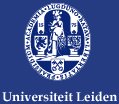 From 1984 to 1991 I studied astronomy at the Leiden University. In 1987 I got my Bachelors
Degree ("Propedeuse" in Dutch). The lectures included not only astronomy but mainly
mathematics and physics. Also computer science was important. I followed a lot of them.
From 1984 to 1991 I studied astronomy at the Leiden University. In 1987 I got my Bachelors
Degree ("Propedeuse" in Dutch). The lectures included not only astronomy but mainly
mathematics and physics. Also computer science was important. I followed a lot of them.
![]() The Leiden Observatory (Huygens Laboratory).
The Leiden Observatory (Huygens Laboratory).
![]() In this period I attended a summerschool at the VLA where I learned a lot
about the theoretical aspects of radio telescopes. Also problems with
radio data and how to solve them where handled nicely.
In this period I attended a summerschool at the VLA where I learned a lot
about the theoretical aspects of radio telescopes. Also problems with
radio data and how to solve them where handled nicely.
![]() I met a lot of young astronomers at the summerschool. I'll look up the
names later. We did not only study of course. We also had a party. People
from all over the world were present (Spain, Argentina, Brazil).
I met a lot of young astronomers at the summerschool. I'll look up the
names later. We did not only study of course. We also had a party. People
from all over the world were present (Spain, Argentina, Brazil).
![]() WENSS Home Page
WENSS Home Page
![]() NFRA Home Page
NFRA Home Page
![]() My TWAIO report
My TWAIO report
![]() ADASS-III conference proceedings
ADASS-III conference proceedings
![]() My ADASS-III contribution
My ADASS-III contribution
![]() Publication: B1620+518 - A Giant Radio Galaxy
(M.N.R.A.S. 282, 1033-1037 - 1996)
Publication: B1620+518 - A Giant Radio Galaxy
(M.N.R.A.S. 282, 1033-1037 - 1996)
![]() Report about VLBI measurements of SS433
Report about VLBI measurements of SS433
![]() I presented some of my work at a conference in Canada in 1993. Try if you
can spot me in the picture.
I presented some of my work at a conference in Canada in 1993. Try if you
can spot me in the picture.
![]() My first office at SRON. Down in the basement I spent a few months here trying to
figure out how CCD's are working.
My first office at SRON. Down in the basement I spent a few months here trying to
figure out how CCD's are working.
XMM System Design
![]() XMM carries three identical, but independent grazing incidence
telescopes, each consisting of a densely nested array of 58
paraboloid-hyperboloid mirror shell pairs in a Wolter Type 1 geometry.
The telescopes have a focal length of 7.5 m. The mirror shells are 300
mm in length.
XMM carries three identical, but independent grazing incidence
telescopes, each consisting of a densely nested array of 58
paraboloid-hyperboloid mirror shell pairs in a Wolter Type 1 geometry.
The telescopes have a focal length of 7.5 m. The mirror shells are 300
mm in length.
The Reflecting Grating Spectrometer (RGS) consists of two independent
instrument chains, utilizing the focussed X-ray light from two of the
three telescopes. Each chain incorporates an array of reflecting
gratings (RGA), which is attached to its respective mirror module.
XMM Scientific Objectives
Since the detection in 1948 of X-rays from the Solar corona, many other
cosmic sources have been identified as X-ray emitters containing hot gas
at temperatures exceeding one million Kelvin. Such highly-ionized, hot
gas is not restricted to the tenous densities of intergalactic and
interstellar space but is also found in a large variety of other
different astrophysical sources including: optically thin sources like
Solar and stellar coronae, clusters of galaxies, galaxies themselves,
supernova remnants, and, at higher densities, accretion-powered sources.
The latter important catagory of sources include compact X-ray binaries,
cataclysmic variables and active nuclei, where the central X-ray
emitting region is surrrounded by a cooler medium that is partially
photo-ionized. Other examples are early-type stars in which X-rays
produced in hot plasma must be transferred outward through a stellar
wind, and stellar sources located near the nucleus of normal galaxies
which are surrounded by the local interstellar medium.
X-ray spectroscopy has proven to be of major relevance in modelling all
of these kinds of plasmas and studying the physical processes that
release the energy and maintain the hot plasmas detected in the variety
of cosmic X-ray sources, both inside and outside the Galaxy.
Measurements of emission lines in such plasmas allow the determination
of physical parameters such as: gas temperature and density, ionization
state, elemental abundances, mass motions, and redshifts. The detection
of absorption features provides similar information in cases where
bright compact X-ray sources are embedded in cooler, extended gas
clouds, which may be ionized by the X-rays.
XMM CCD Calibration
SRON is responsible for building the two spectrometers for XMM. A lot of
work is put into the development of CCD's that can detected X-rays. In
order to test these CCD's a large test facility is build to analize the
devices. These facilities consist of a vacuum tank with cryogenic
cooloing where X-rays can be produced. Because the measurements are
usually time consuming this process has been automated. The software to
produce script files (input files with selected parameters) for several
software packages were written by me. This software is written in Tcl/Tk
(a relatively new script language) and is platform independent. Without
recompiling the source code can run on both the Sun workstation and on
the PC running Windows. Script files are made for 1) a program that
controls a slave PC (connected with RS-232 port), 2) the CCD control
program and 3) a ORACLE database which stores the measurement
parameters.
![]() CCD measurement facility (Cal-Fac).
CCD measurement facility (Cal-Fac).
With the Tcl/Tk software building scripts and linking them together into
a batch file (a DOS based BAT file) is very easy. Since Tcl/Tk has
build-in commands to make graphical user interfaces, it is just a matter
of point and click to enable options like filters, fluoresent target,
current and voltage of X-ray source, control voltages for the CCD,
shutter control and cooling temperature.
HEAD (High Energy Astrophysics divison Data analysis)
![]()
After a satellite is launched a lot of (scientific) data is send back to
the astronomical institutes. These data have to be processed in order to
do science with them. Nowadays most of this processing is done
automatically. Because there are several missions planned within the
high energy department a combined software platform has been developed
to automate the data reduction. The software is written in C (with
ORACLE preprocessor instructions) and Tck/Tk. The software that I have
written for this project dealt with the data heritage. FITS files are
used to store the parameters used by scientific software and these
parameters are stored in a database.
XMM EGSE
The Electrical Ground Support Equipment (EGSE) consists of a central
workstation connected to a VME-crate which contains a number of
processors and dedicated interface boards. At the central workstation
the main EGSE program (Instrument Station) is running which controls the
instrument through the dedicated interface hardware (Interface
Simulator). This concept allows for gradual changes, depending on the
phase of the program, including the replacement of the Interface
Simulator by the Central Checkout System (CCS). Since january 1996 I have
written software for the Spacecraft Simulator. This is C code running on a
real-time operating system (VxWorks).
![]() My office at SRON that I have shared with Chiel and Erik.
My office at SRON that I have shared with Chiel and Erik.
XMM Panter test 1996
In 1996 a big measuring campain was held to test
many parts of the instrument, like the spectrometer, the grating box and
the mirror assembly. This test was done during a 7 week period in
Neuried bei Munchen at the Panter Facility.
SCIAMACHY EGSE
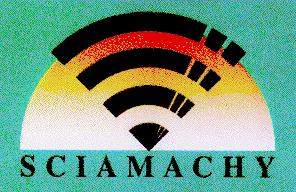 I have worked on a new series of software routines to extend the
SCOE (Special Check Out Equipment) that was used to test the Detector Modules
of Sciamachy with some EGSE (Electrical Ground Support Equipment) functionality. Then
you can also do some performance tests on the instrument, like checking
the spectral resolution, bad/dead pixels, signal to noise and field of view. I also wrote
software to test the alignment of the detectors. Most of this software is written in IDL.
I have worked on a new series of software routines to extend the
SCOE (Special Check Out Equipment) that was used to test the Detector Modules
of Sciamachy with some EGSE (Electrical Ground Support Equipment) functionality. Then
you can also do some performance tests on the instrument, like checking
the spectral resolution, bad/dead pixels, signal to noise and field of view. I also wrote
software to test the alignment of the detectors. Most of this software is written in IDL.
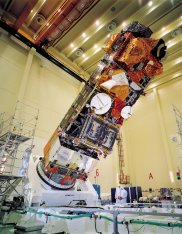
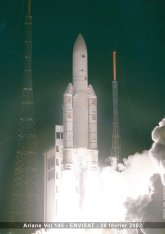 Sciamachy is one of the ten instruments on-board Envisat, the largest satellite
ever build by ESA. It was launched on 1 March 2002.
Sciamachy is one of the ten instruments on-board Envisat, the largest satellite
ever build by ESA. It was launched on 1 March 2002.
SRON-Info

SRON-Info is the Intranet of SRON. This Web based system is made with both static HTML
pages and software generated pages. It is made with Tcl/Tk with special Oracle extensions
(Oratcl) to access the SRON database server. Modules like an address browser, document
archive, and a purchase order system are build this way. Its a pitty that only people
within the SRON organization can see it. For more then 2 years I have made software
for this system and now others can maintain it.
SRON MIS
 |
 |
XMM the sequel
 Back on the old
project, I still write software tools to make other people happy. In
November 1999 I moved to Spain to work there for a year as Instrument Specialist. Near
Madrid there is Vilspa (Villafranca del Castilla, Spain), where the Science Operations
Center is located. The launch date for XMM was 10 December 1999.
I have some information about the activities
in Kourou (French Guiana) from the period just before launch. And also the
launch itself. There is more to come, because the
launch was succesful. Meanwhile I've made a page with the
status reports for the first
part of the mission. In January 2000 the first real work started in terms
of operations: Commissioning. During this period all instruments are switched
on for the first time and all different instrument modes are tested. This is
also the moment when the first light pictures
are made.
Back on the old
project, I still write software tools to make other people happy. In
November 1999 I moved to Spain to work there for a year as Instrument Specialist. Near
Madrid there is Vilspa (Villafranca del Castilla, Spain), where the Science Operations
Center is located. The launch date for XMM was 10 December 1999.
I have some information about the activities
in Kourou (French Guiana) from the period just before launch. And also the
launch itself. There is more to come, because the
launch was succesful. Meanwhile I've made a page with the
status reports for the first
part of the mission. In January 2000 the first real work started in terms
of operations: Commissioning. During this period all instruments are switched
on for the first time and all different instrument modes are tested. This is
also the moment when the first light pictures
are made.
Starting from revolution 46 (9 March 2000) the next phase started: Calibration and
Performance Verification (CAL/PV). Measurements are taken to test the performance of
the instruments in-flight and to calibrate the instruments. For the RGS instruments
the most important calibrations are the wavelength calibration and the effective area
measurements.
Meanwhile people are trying to take pictures from Earth using big telescopes
to track down the satellite.
You can see me in action at the INSCONs console
at VILSPA.
In revolution 102 the first guaranteed time data were taken. XMM-Newton is
starting the routine measurements. At this point I got more time to work on software.
So I build a package that contains all the information about all observations taken
by all instruments on board XMM. This database in now used by both instrument specialists
and the whole user community to find out what data has been taken by the satellite and
under what conditions.
In January 2001 I left VILSPA and returned to the Netherlands.
 I now work as a senior engineer for a British company called VEGA, in the Space Department.
VEGA Group PLC is an Information Technology (IT) services company, which provides
expert consultancy and applied technology to help companies optimise their business
processes, successfully implement new technology and develop their staff.
I now work as a senior engineer for a British company called VEGA, in the Space Department.
VEGA Group PLC is an Information Technology (IT) services company, which provides
expert consultancy and applied technology to help companies optimise their business
processes, successfully implement new technology and develop their staff.
Planck
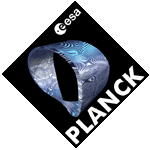 I am now working
for a new project called Planck at Estec in Noordwijk. Planck is one of the European
Space Agency's scientific missions planned for the first decade of the millennium.
It has been designed to help answer key questions for humankind: how did the Universe
come to be and how will it evolve. To fulfil its mission Planck will examine the first
light that filled the Universe after the Big Bang, the Cosmic Microwave Background
radiation (CMB). Planck will be launched in the year 2007, together with ESA's next
infrared and submillimetre space observatory, Herschel Space Observatory (formerly
called FIRST).
I am now working
for a new project called Planck at Estec in Noordwijk. Planck is one of the European
Space Agency's scientific missions planned for the first decade of the millennium.
It has been designed to help answer key questions for humankind: how did the Universe
come to be and how will it evolve. To fulfil its mission Planck will examine the first
light that filled the Universe after the Big Bang, the Cosmic Microwave Background
radiation (CMB). Planck will be launched in the year 2007, together with ESA's next
infrared and submillimetre space observatory, Herschel Space Observatory (formerly
called FIRST).
I am a Ground Segment System Engineer, so I will help ESA and the institutes that build
the instruments in organizing the scientific datastream into a homogeneous system.
This document was last updated on 03/03/02